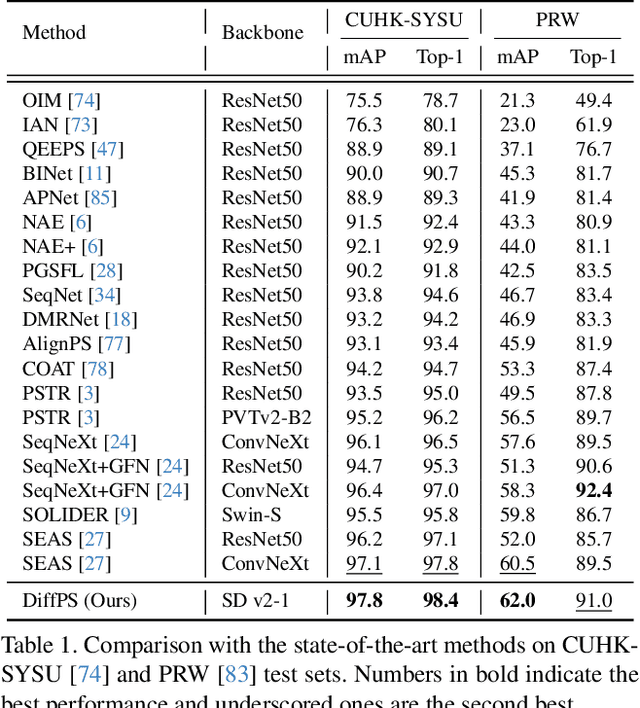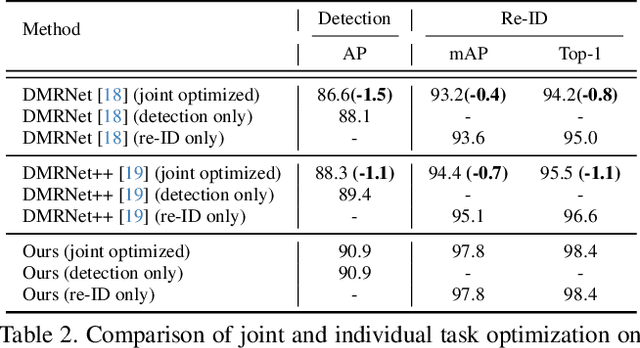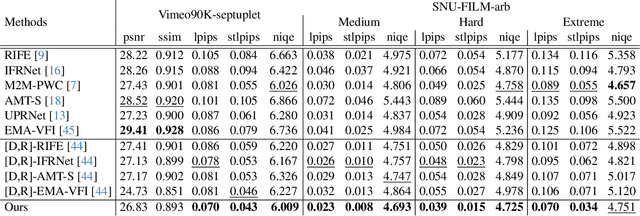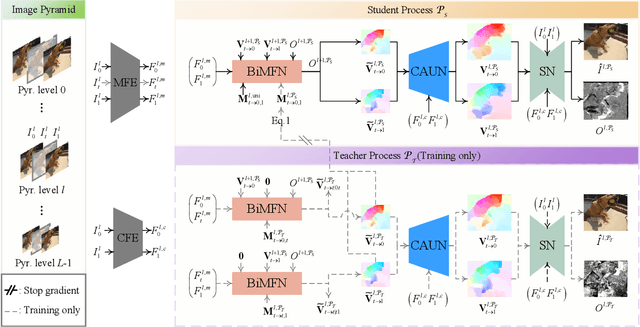Jihyong Oh
Leveraging Prior Knowledge of Diffusion Model for Person Search
Oct 02, 2025



Abstract:Person search aims to jointly perform person detection and re-identification by localizing and identifying a query person within a gallery of uncropped scene images. Existing methods predominantly utilize ImageNet pre-trained backbones, which may be suboptimal for capturing the complex spatial context and fine-grained identity cues necessary for person search. Moreover, they rely on a shared backbone feature for both person detection and re-identification, leading to suboptimal features due to conflicting optimization objectives. In this paper, we propose DiffPS (Diffusion Prior Knowledge for Person Search), a novel framework that leverages a pre-trained diffusion model while eliminating the optimization conflict between two sub-tasks. We analyze key properties of diffusion priors and propose three specialized modules: (i) Diffusion-Guided Region Proposal Network (DGRPN) for enhanced person localization, (ii) Multi-Scale Frequency Refinement Network (MSFRN) to mitigate shape bias, and (iii) Semantic-Adaptive Feature Aggregation Network (SFAN) to leverage text-aligned diffusion features. DiffPS sets a new state-of-the-art on CUHK-SYSU and PRW.
MoCHA-former: Moiré-Conditioned Hybrid Adaptive Transformer for Video Demoiréing
Aug 21, 2025Abstract:Recent advances in portable imaging have made camera-based screen capture ubiquitous. Unfortunately, frequency aliasing between the camera's color filter array (CFA) and the display's sub-pixels induces moir\'e patterns that severely degrade captured photos and videos. Although various demoir\'eing models have been proposed to remove such moir\'e patterns, these approaches still suffer from several limitations: (i) spatially varying artifact strength within a frame, (ii) large-scale and globally spreading structures, (iii) channel-dependent statistics and (iv) rapid temporal fluctuations across frames. We address these issues with the Moir\'e Conditioned Hybrid Adaptive Transformer (MoCHA-former), which comprises two key components: Decoupled Moir\'e Adaptive Demoir\'eing (DMAD) and Spatio-Temporal Adaptive Demoir\'eing (STAD). DMAD separates moir\'e and content via a Moir\'e Decoupling Block (MDB) and a Detail Decoupling Block (DDB), then produces moir\'e-adaptive features using a Moir\'e Conditioning Block (MCB) for targeted restoration. STAD introduces a Spatial Fusion Block (SFB) with window attention to capture large-scale structures, and a Feature Channel Attention (FCA) to model channel dependence in RAW frames. To ensure temporal consistency, MoCHA-former performs implicit frame alignment without any explicit alignment module. We analyze moir\'e characteristics through qualitative and quantitative studies, and evaluate on two video datasets covering RAW and sRGB domains. MoCHA-former consistently surpasses prior methods across PSNR, SSIM, and LPIPS.
Domain Generalization for Person Re-identification: A Survey Towards Domain-Agnostic Person Matching
Jun 14, 2025Abstract:Person Re-identification (ReID) aims to retrieve images of the same individual captured across non-overlapping camera views, making it a critical component of intelligent surveillance systems. Traditional ReID methods assume that the training and test domains share similar characteristics and primarily focus on learning discriminative features within a given domain. However, they often fail to generalize to unseen domains due to domain shifts caused by variations in viewpoint, background, and lighting conditions. To address this issue, Domain-Adaptive ReID (DA-ReID) methods have been proposed. These approaches incorporate unlabeled target domain data during training and improve performance by aligning feature distributions between source and target domains. Domain-Generalizable ReID (DG-ReID) tackles a more realistic and challenging setting by aiming to learn domain-invariant features without relying on any target domain data. Recent methods have explored various strategies to enhance generalization across diverse environments, but the field remains relatively underexplored. In this paper, we present a comprehensive survey of DG-ReID. We first review the architectural components of DG-ReID including the overall setting, commonly used backbone networks and multi-source input configurations. Then, we categorize and analyze domain generalization modules that explicitly aim to learn domain-invariant and identity-discriminative representations. To examine the broader applicability of these techniques, we further conduct a case study on a related task that also involves distribution shifts. Finally, we discuss recent trends, open challenges, and promising directions for future research in DG-ReID. To the best of our knowledge, this is the first systematic survey dedicated to DG-ReID.
I-INR: Iterative Implicit Neural Representations
Apr 24, 2025Abstract:Implicit Neural Representations (INRs) have revolutionized signal processing and computer vision by modeling signals as continuous, differentiable functions parameterized by neural networks. However, their inherent formulation as a regression problem makes them prone to regression to the mean, limiting their ability to capture fine details, retain high-frequency information, and handle noise effectively. To address these challenges, we propose Iterative Implicit Neural Representations (I-INRs) a novel plug-and-play framework that enhances signal reconstruction through an iterative refinement process. I-INRs effectively recover high-frequency details, improve robustness to noise, and achieve superior reconstruction quality. Our framework seamlessly integrates with existing INR architectures, delivering substantial performance gains across various tasks. Extensive experiments show that I-INRs outperform baseline methods, including WIRE, SIREN, and Gauss, in diverse computer vision applications such as image restoration, image denoising, and object occupancy prediction.
MoBGS: Motion Deblurring Dynamic 3D Gaussian Splatting for Blurry Monocular Video
Apr 21, 2025Abstract:We present MoBGS, a novel deblurring dynamic 3D Gaussian Splatting (3DGS) framework capable of reconstructing sharp and high-quality novel spatio-temporal views from blurry monocular videos in an end-to-end manner. Existing dynamic novel view synthesis (NVS) methods are highly sensitive to motion blur in casually captured videos, resulting in significant degradation of rendering quality. While recent approaches address motion-blurred inputs for NVS, they primarily focus on static scene reconstruction and lack dedicated motion modeling for dynamic objects. To overcome these limitations, our MoBGS introduces a novel Blur-adaptive Latent Camera Estimation (BLCE) method for effective latent camera trajectory estimation, improving global camera motion deblurring. In addition, we propose a physically-inspired Latent Camera-induced Exposure Estimation (LCEE) method to ensure consistent deblurring of both global camera and local object motion. Our MoBGS framework ensures the temporal consistency of unseen latent timestamps and robust motion decomposition of static and dynamic regions. Extensive experiments on the Stereo Blur dataset and real-world blurry videos show that our MoBGS significantly outperforms the very recent advanced methods (DyBluRF and Deblur4DGS), achieving state-of-the-art performance for dynamic NVS under motion blur.
MoDec-GS: Global-to-Local Motion Decomposition and Temporal Interval Adjustment for Compact Dynamic 3D Gaussian Splatting
Jan 07, 2025



Abstract:3D Gaussian Splatting (3DGS) has made significant strides in scene representation and neural rendering, with intense efforts focused on adapting it for dynamic scenes. Despite delivering remarkable rendering quality and speed, existing methods struggle with storage demands and representing complex real-world motions. To tackle these issues, we propose MoDecGS, a memory-efficient Gaussian splatting framework designed for reconstructing novel views in challenging scenarios with complex motions. We introduce GlobaltoLocal Motion Decomposition (GLMD) to effectively capture dynamic motions in a coarsetofine manner. This approach leverages Global Canonical Scaffolds (Global CS) and Local Canonical Scaffolds (Local CS), extending static Scaffold representation to dynamic video reconstruction. For Global CS, we propose Global Anchor Deformation (GAD) to efficiently represent global dynamics along complex motions, by directly deforming the implicit Scaffold attributes which are anchor position, offset, and local context features. Next, we finely adjust local motions via the Local Gaussian Deformation (LGD) of Local CS explicitly. Additionally, we introduce Temporal Interval Adjustment (TIA) to automatically control the temporal coverage of each Local CS during training, allowing MoDecGS to find optimal interval assignments based on the specified number of temporal segments. Extensive evaluations demonstrate that MoDecGS achieves an average 70% reduction in model size over stateoftheart methods for dynamic 3D Gaussians from realworld dynamic videos while maintaining or even improving rendering quality.
MIVE: New Design and Benchmark for Multi-Instance Video Editing
Dec 17, 2024



Abstract:Recent AI-based video editing has enabled users to edit videos through simple text prompts, significantly simplifying the editing process. However, recent zero-shot video editing techniques primarily focus on global or single-object edits, which can lead to unintended changes in other parts of the video. When multiple objects require localized edits, existing methods face challenges, such as unfaithful editing, editing leakage, and lack of suitable evaluation datasets and metrics. To overcome these limitations, we propose a zero-shot $\textbf{M}$ulti-$\textbf{I}$nstance $\textbf{V}$ideo $\textbf{E}$diting framework, called MIVE. MIVE is a general-purpose mask-based framework, not dedicated to specific objects (e.g., people). MIVE introduces two key modules: (i) Disentangled Multi-instance Sampling (DMS) to prevent editing leakage and (ii) Instance-centric Probability Redistribution (IPR) to ensure precise localization and faithful editing. Additionally, we present our new MIVE Dataset featuring diverse video scenarios and introduce the Cross-Instance Accuracy (CIA) Score to evaluate editing leakage in multi-instance video editing tasks. Our extensive qualitative, quantitative, and user study evaluations demonstrate that MIVE significantly outperforms recent state-of-the-art methods in terms of editing faithfulness, accuracy, and leakage prevention, setting a new benchmark for multi-instance video editing. The project page is available at https://kaist-viclab.github.io/mive-site/
BiM-VFI: directional Motion Field-Guided Frame Interpolation for Video with Non-uniform Motions
Dec 16, 2024



Abstract:Existing Video Frame interpolation (VFI) models tend to suffer from time-to-location ambiguity when trained with video of non-uniform motions, such as accelerating, decelerating, and changing directions, which often yield blurred interpolated frames. In this paper, we propose (i) a novel motion description map, Bidirectional Motion field (BiM), to effectively describe non-uniform motions; (ii) a BiM-guided Flow Net (BiMFN) with Content-Aware Upsampling Network (CAUN) for precise optical flow estimation; and (iii) Knowledge Distillation for VFI-centric Flow supervision (KDVCF) to supervise the motion estimation of VFI model with VFI-centric teacher flows. The proposed VFI is called a Bidirectional Motion field-guided VFI (BiM-VFI) model. Extensive experiments show that our BiM-VFI model significantly surpasses the recent state-of-the-art VFI methods by 26% and 45% improvements in LPIPS and STLPIPS respectively, yielding interpolated frames with much fewer blurs at arbitrary time instances.
SplineGS: Robust Motion-Adaptive Spline for Real-Time Dynamic 3D Gaussians from Monocular Video
Dec 13, 2024



Abstract:Synthesizing novel views from in-the-wild monocular videos is challenging due to scene dynamics and the lack of multi-view cues. To address this, we propose SplineGS, a COLMAP-free dynamic 3D Gaussian Splatting (3DGS) framework for high-quality reconstruction and fast rendering from monocular videos. At its core is a novel Motion-Adaptive Spline (MAS) method, which represents continuous dynamic 3D Gaussian trajectories using cubic Hermite splines with a small number of control points. For MAS, we introduce a Motion-Adaptive Control points Pruning (MACP) method to model the deformation of each dynamic 3D Gaussian across varying motions, progressively pruning control points while maintaining dynamic modeling integrity. Additionally, we present a joint optimization strategy for camera parameter estimation and 3D Gaussian attributes, leveraging photometric and geometric consistency. This eliminates the need for Structure-from-Motion preprocessing and enhances SplineGS's robustness in real-world conditions. Experiments show that SplineGS significantly outperforms state-of-the-art methods in novel view synthesis quality for dynamic scenes from monocular videos, achieving thousands times faster rendering speed.
FMA-Net: Flow-Guided Dynamic Filtering and Iterative Feature Refinement with Multi-Attention for Joint Video Super-Resolution and Deblurring
Jan 08, 2024Abstract:We present a joint learning scheme of video super-resolution and deblurring, called VSRDB, to restore clean high-resolution (HR) videos from blurry low-resolution (LR) ones. This joint restoration problem has drawn much less attention compared to single restoration problems. In this paper, we propose a novel flow-guided dynamic filtering (FGDF) and iterative feature refinement with multi-attention (FRMA), which constitutes our VSRDB framework, denoted as FMA-Net. Specifically, our proposed FGDF enables precise estimation of both spatio-temporally-variant degradation and restoration kernels that are aware of motion trajectories through sophisticated motion representation learning. Compared to conventional dynamic filtering, the FGDF enables the FMA-Net to effectively handle large motions into the VSRDB. Additionally, the stacked FRMA blocks trained with our novel temporal anchor (TA) loss, which temporally anchors and sharpens features, refine features in a course-to-fine manner through iterative updates. Extensive experiments demonstrate the superiority of the proposed FMA-Net over state-of-the-art methods in terms of both quantitative and qualitative quality. Codes and pre-trained models are available at: https://kaist-viclab.github.io/fmanet-site
 Add to Chrome
Add to Chrome Add to Firefox
Add to Firefox Add to Edge
Add to Edge